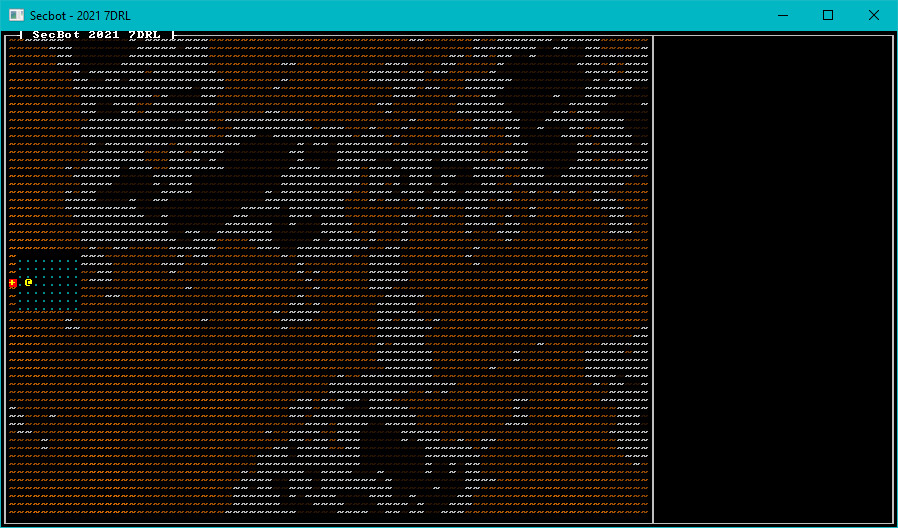This tutorial is free and open source, and all code uses the MIT license - so you are free to do with it as you like. My hope is that you will enjoy the tutorial, and make great games!
If you enjoy this and would like me to keep writing, please consider supporting my Patreon.
Building an Asteroid
I knew that SecBot was landing on an asteroid outpost, a mining colony run by the not-so-pleasant Bracket Corporation (I like making myself the bad guy in games!). The landscape is interesting: it needs to be pretty, because you can see it out of the window. It also doesn't do anything beyond looking pretty. Fortunately, I had an idea for making it quickly.
Simplex Noise
I love noise functions. I implemented Auburn's FastNoise library in Rust as part of bracket-lib, simply because I use noise functions so much. Simplex Noise is a great way to get a height-map that looks a lot like a landscape, with very little effort. I wrote a tutorial on how to build a globe a while back, and shamelessly borrowed some of my code from there.
Simplex noise takes some parameters, and gives you a set of density or altitude numbers for given coordinates. In this case, I went with the number representing altitude. I wanted large numbers to be brighter, indicating high ground. Low numbers are darker, and really low numbers render as a deep maroon. Open map/tile.rs and add a new tile constructor to the implementation block:
#![allow(unused)] fn main() { pub fn alien_landscape(height: f32) -> Self { let fg = if height < 0.0 { if height < -0.25 { (40, 20, 0) } else { GRAY } } else { ( (height * 128.0) as u8 + 128, ((height * 128.0) as u8 + 128) / 2, 0 ) }; Self { glyph: to_cp437('~'), color: ColorPair::new(fg, BLACK), blocked: false, opaque: false, } } }
I played around with this until I liked the results. I encourage you to do the same.
Now open map/layerbuilder/entrance.rs and add a call to a new function to the builder routine:
#![allow(unused)] fn main() { all_space(&mut layer); add_landscape(&mut layer, ecs); add_docking_capsule(&mut layer, ecs); }
add_landscape is actually quite straightforward if you are familiar with noise functions:
#![allow(unused)] fn main() { fn add_landscape(map: &mut Layer, ecs: &mut World) { let mut rng_lock = crate::RNG.lock(); let rng = rng_lock.as_mut().unwrap(); let mut noise = FastNoise::seeded(rng.next_u64()); noise.set_noise_type(NoiseType::SimplexFractal); noise.set_fractal_type(FractalType::FBM); noise.set_fractal_octaves(10); noise.set_fractal_gain(0.5); noise.set_fractal_lacunarity(3.5); noise.set_frequency(0.02); for y in 0..HEIGHT { for x in 0..WIDTH { let h = noise.get_noise(x as f32, y as f32); let idx = map.point2d_to_index(Point::new(x, y)); map.tiles[idx] = Tile::alien_landscape(h); } } } }
It starts by obtaining a lock on the RNG mutex. Again, I wish I'd used parking_lot - instead of two lines, it could just be let mut rng = crate::RNG.lock(). It's not too bad to use two lines of code, I guess.
The function then generates a seeded FastNoise structure, using a random seed. It sets the noise type to SimplexFractal - which generates continuous noise (you can zoom in), using the simplex noise system - which basically merges gradients to give smoothly transitioning scenery. I coped the parameters from the world building example. It then iterates the whole map, grabs a noise value for the map coordinate and sets that tile to alien_landscape with the generated height.
Since the remainder of the level is generated after the landscape, I let it cover the whole map - and then overwrite the parts that will be used for gameplay.
Give it a Spin
If you run the program now, you have generated an asteroid surface:

You can find the source code for
hello_asteroidhere.
Up Next
Next, we'll add some walls around SecBot's capsule. We'll add windows and a field-of-view system to let SecBot peek out the window to see the world.
